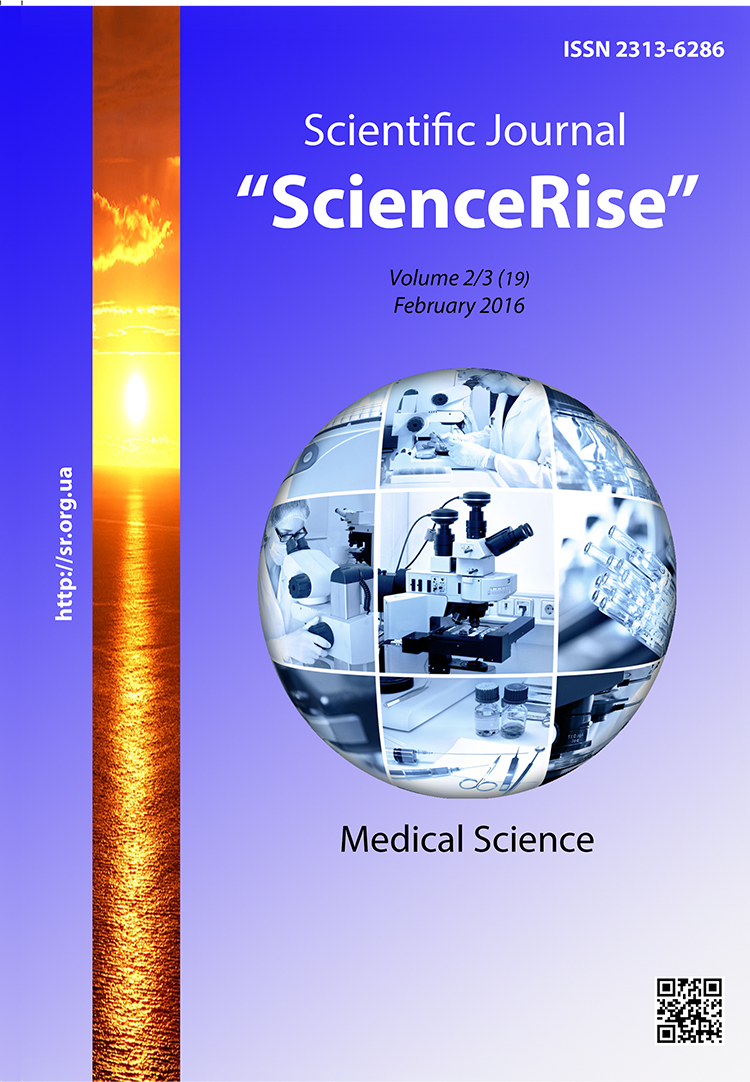Взаимосвязь показателей микробиоценоза кишечника и местного иммунитета у детей, больных реактивными артритами
DOI:
https://doi.org/10.15587/2313-8416.2016.61080Ключові слова:
реактивный артрит, дети, микробиоценоз кишечника, условно-патогенная флора, секреторный иммуноглобулин ААнотація
В данной работе определены частота и степень нарушений микробиоценоза кишечника и состояние местного иммунитета (секреторный иммуноглобулин А) у детей больных реактивными артритами (РеА) в остром периоде и через 9–12 месяцев от начала заболевания. Выявлена достоверная прямая связь уровня секреторного иммуноглобулина А со степенью дисбиоза. Секреторный иммуноглобулин А следует рассматривать как один из прогностических факторов, влияющих на течение реактивного артрита
Посилання
Marushko, T. V. (2012). Reaktyvni artropatii' u ditej. Ukrai'ny, 2, 43–44.
Natal'chenko, G. I. (2011). Jetiopatogenez, klinika, diagnostika reaktivnyh artritov u detej: (obzor literatury). Perinatologija i pediatrija, 2, 110–112.
Hannu, T. (2011). Reactive arthritis. Best Practice & Research Clinical Rheumatology, 25 (3), 347–357. doi: 10.1016/j.berh.2011.01.018
Lebec', I. S., Pan'ko, N. O. (2013). Osoblyvosti debjutu ta perebigu reaktyvnyh artrytiv u ditej. Zdorov'e rebenka, 6, 37–42.
Kovalenko, V. N., Shuba, N. M. (2013). Nacional'nyj pidruchnyk z revmatologii'. Kyiv: MORION, 672.
Fadeenko, G. D. (2010). Narushenie kishechnogo mikrobiocenoza i ego korrekcija pri vospalitel'nyh zabolevanijah kishechnika na osnove dokazatel'noj mediciny. Suchasna gastroenterologіja, 3, 127–132.
Shadrin, O. G., Misnik, V. P., Ponomareva, I. G., Klimenko, L. A. (2014). K voprosu formirovanija jeubioza kishechnika pri iskusstvennom vskarmlivanii detej grudnogo vozrasta. Gastrojenterologija i gepatologija, 1 (57), 122–126.
Jankovskij, D. S., Moiseenko, R. A., Dyment, G. S. (2010). Mesto disbioza v patologii cheloveka. Sovr. Pediatrija, 1 (29), 154–167.
Bilovol, O. M., Kravchun, P. G., Babadzhan, V. D. et. al (2011). Klinichna imunologija ta alergologija. Kharkiv: Gryf, 550.
Kopanev, Ju. A. (2009). Vzaimosvjaz' funkcii mestnogo immuniteta i mikrobiocenoza kishechnika, vozmozhnosti immunokorrekcii disbakterioza. Lechashhij vrach, 9, 66–69.
##submission.downloads##
Опубліковано
Номер
Розділ
Ліцензія
Авторське право (c) 2016 Татьяна Алексеевна Твердохлеб

Ця робота ліцензується відповідно до Creative Commons Attribution 4.0 International License.
Наше видання використовує положення про авторські права Creative Commons CC BY для журналів відкритого доступу.
Автори, які публікуються у цьому журналі, погоджуються з наступними умовами:
1. Автори залишають за собою право на авторство своєї роботи та передають журналу право першої публікації цієї роботи на умовах ліцензії Creative Commons CC BY, котра дозволяє іншим особам вільно розповсюджувати опубліковану роботу з обов'язковим посиланням на авторів оригінальної роботи та першу публікацію роботи у цьому журналі.
2. Автори мають право укладати самостійні додаткові угоди щодо неексклюзивного розповсюдження роботи у тому вигляді, в якому вона була опублікована цим журналом (наприклад, розміщувати роботу в електронному сховищі установи або публікувати у складі монографії), за умови збереження посилання на першу публікацію роботи у цьому журналі.

